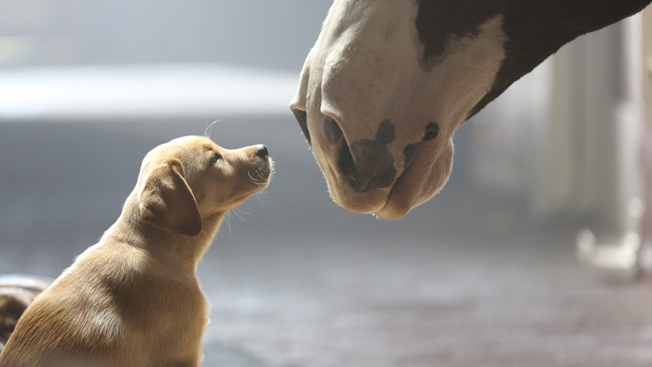We Ask an Expert: Why Do Dogs Dominate the Super Bowl?
Posted in: Uncategorized
With a cute canine-powered commercial from Budweiser chewing up its competition ahead of the big game, I decided to ask dog expert Brian Hare why a pooch is so often an adman's best friend.
"We share a lot of history with dogs that we do not share with any other animal," says Hare. "We've been evolving together for tens of thousands of years. This creates a special connection that is unique to our two species."
Judging from his pedigree, Hare should know. He serves as the director of the Canine Cognition Center at Duke University and co-founder of Dognition, a service dedicated to helping pet owners understand how their dogs think. (Ad shop McKinney helped create the service and its website.) With his wife, Vanessa Woods, Hare co-wrote The New York Times' best-seller The Genius of Dogs.
Sure, dogs are cute, but Hare believes there are deeper reasons that consumers respond so strongly, and in such positive ways, to ad campaigns that feature these animals.
"When you see a dog," he says, "it's not like looking at a tiger or a shark. It's like looking at someone familiar, someone you know and recognize. This sense of familiarity and comfort is very valuable to advertising."
That's certainly true for Budweiser's "Puppy Love," a 60-second commercial from Anomaly that tells the tale of a 10-week-old puppy who keeps escaping from an adoption center and cozying up to the Clydesdales on a nearby farm. The spot debuted on Wednesday's Today show, and in just over 30 hours online, "Puppy Love" is nearing 20 million YouTube views, making it by far the most-watched 2014 Super Bowl ad released prior to the game. It's also fetching massive feel-good buzz for the brand in social and mainstream media.
"This year's Budweiser commercial with the Clydesdales and puppy creates a very heartwarming story, pulling out all the stops and using our relationship with both of these animals very effectively," Hare says. "Seeing a dog brings up positive feelings that no other animal can to the same extent. Horses convey power and grace."
Overall, he says, the puppy-horse combo creates "incredibly strong positive feelings around the brand."
But, doggonnit, this year's Super Bowl is also big on bears, with ursine incursions into commercials for Chobani, Beats Music and CarMax. (Actually, CarMax displays some puppy power too, with a Web version of its "Slow Clap" game day spot retitled "Slow Bark" and recast with pooches.) Elsewhere in animal-related big game ads, a bull-ish bachelor horns in on Chevy's Silverado and Audi breeds the Doberhuahua, a freakish mutant mutt.
Hare maintains that no other critters meet advertiser needs quite like dogs (real ones, not CGI-created Doberman-Chihuahua hybrids on a rampage). He says the combination of cuteness and familiarity helps bowsers win every time, even over the cotton-tailed charms of bunnies. (Perhaps a surprising assertion from a guy named Hare.)
Should some animals be barred from ads entirely? "Depending on the ad's intent, snakes are something to be wary of." Hare's also no fan of primates in commercials "because the abuse of chimpanzees is well documented within the entertainment industry."
So what about the Internet's favorite animal, the cat?
The feline fiends inexplicably get a couple of showcases on Sunday They'll hiss and spit, I imagine, across Hallmark Channel's Kitten Bowl, and cough up hairballs on Animal Planet's Kitty Half-Time Show—which is just an intermission during the cable network's Puppy Bowl anyway.
According to Hare: "Even though cats have also been companion animals for thousands of years, our relationship with dogs seems to be particularly extraordinary in comparison. Research shows that dogs can read our gestures, feel our emotions and even sense changes in our health better than most cats."
There, science proves it: When it comes to ads at least, cats aren't up to scratch.
![]()






Post a Comment